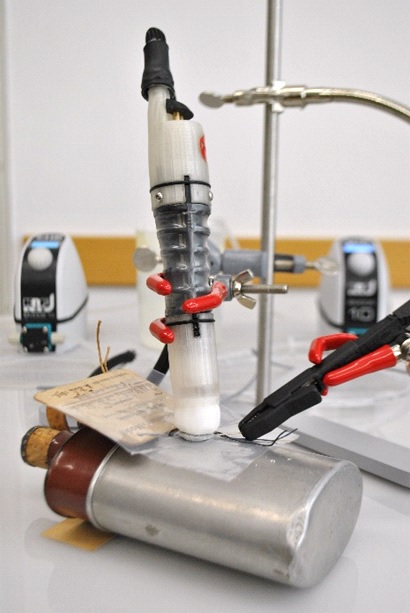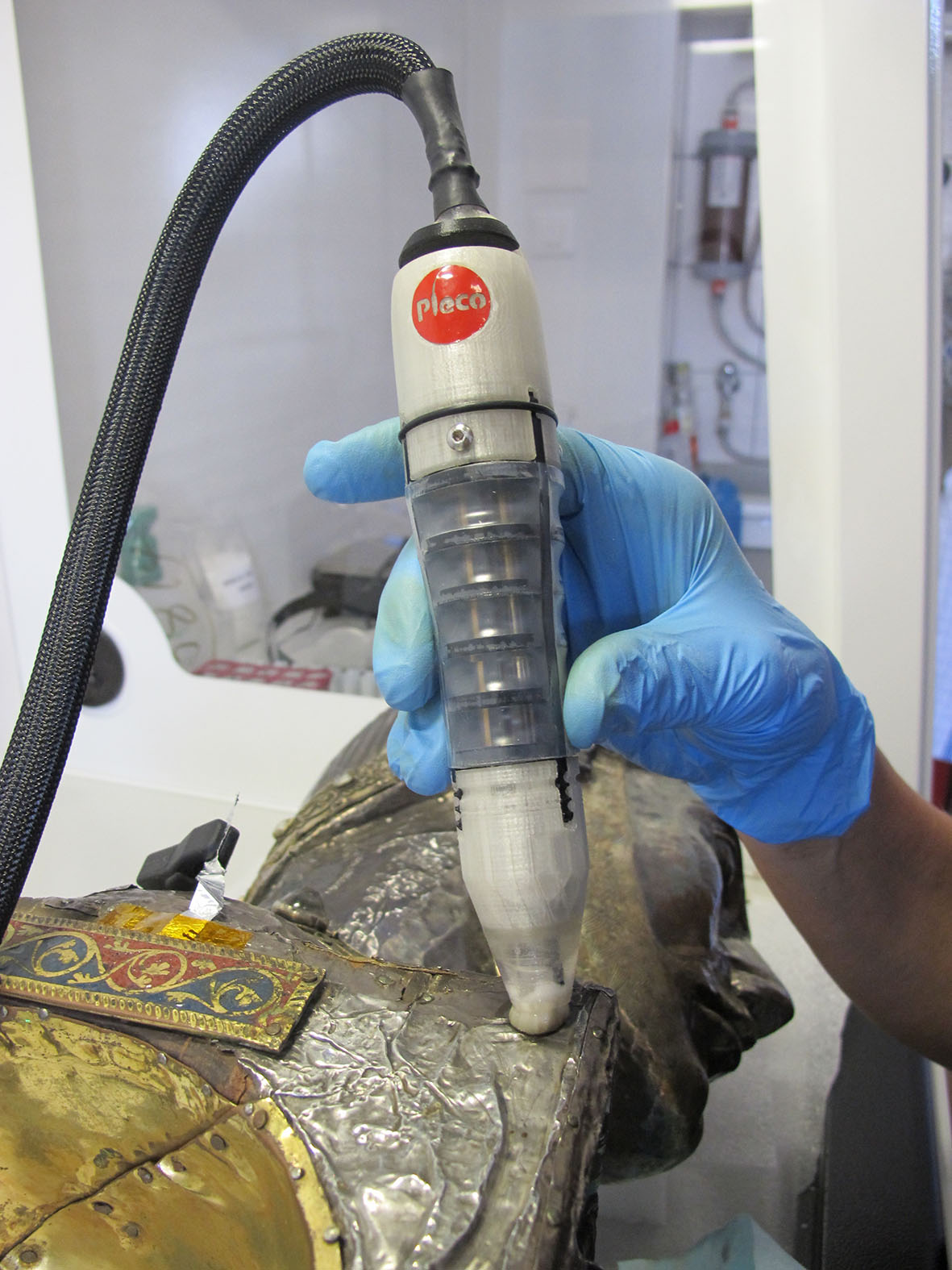You are not logged in.
- Topics: Active | Unanswered
The Pleco
|
The Pleco[1] is a newly designed electrolytic pencil made from parts you fabricate and assemble yourself. It is ergonomic and easy to use. Conceived initially for the local cleaning of silver tarnish by electrolytic reduction, the Pleco enables an alternative to treating artefacts by immersion. |
|||||
|
|
 |
||||
|
Overview of the Pleco being used in dynamic mode. During treatment the solution is continuously supplied to and drained from the nozzle of the pencil. The tarnished silver plate on which the Pleco is applied becomes the working electrode of the electrolytic cell, while the platinum counter-electrode and vitreous carbon reference electrode are inside the conical nozzle, ©Atelier de l’Abbaye de Saint-Maurice. |
|
The Pleco used on a lead seal still attached to a flask of the Foundation of the historical material of the Swiss army. The cylindrical nozzle allows to use a large pad to treat the whole seal. The consolidative reduction being a slow process, the treatment is carried out in static mode. ©Célia Fontaine, Stiftung HAM. |
|||
|
The principal innovation of the Pleco involves the use of diaphragm pumps to continuously supply and extract treatment solution (electrolyte) for treating the metal surface (working electrode). The 3-electrode cell at the nozzle of the pencil includes the metal to be cleaned, a platinum rod (counter-electrode) and a vitreous carbon rod (reference electrode). Also within the cell are the ends of the electrolyte circulation tubes. The nozzle is closed by a pad made from a micro-porous polyvinyl formal (PVF) foam. This material is chemically stable, has a good mechanical strength, excellent absorption and retention of the electrolyte and only slightly affects the applied electrolytic parameters. With this system, the risk of leakage is prevented as well as any associated secondary effect In static mode, the Pleco enables characterization of the alteration using cathodic linear voltammetry (see section Electrochemistry/ Fundamentals). In the case of silver tarnish: - Tarnishing due to handling (peak AgCl⇒Ag), - Tarnishing due to the presence of reduced sulphur species in the atmosphere (peak Ag2S⇒Ag). and defining the parameters for electrolytic treatment: - Cathodic potential to reduce silver tarnish (maximum of the peaks AgCl⇒Ag or Ag2S⇒Ag), - Anodic potential to dissolve reduced silver on gilt silver (maximum of the peak Agreduced⇒Ag+). In dynamic mode and using chrono-amperometry with the previously defined potentials (see section Electrochemistry/ Fundamentals), the Pleco ensures the treatment required. The Pleco has been applied with success to clean silver tarnish on silver and gilt silver objects as well as to stabilize active lead exposed to corrosive organic vapours. We plan to test it on other materials such as copper and iron alloys suffering from active corrosion. The objective is to stabilize these materials by removing active species. The pencil has been optimized by the provision of a stand for the Pleco when not in use and the development of a cheaper pumping system (see section Downloads / Accessories). The latter exists only as a prototype which use should be validated in the next months. The Pleco was fabricated within the framework of the Saint-Maurice research project, which was funded by the Competence Network of Design and Visual Arts at the University of Applied Sciences, Western Switzerland (HES-SO) and also by regional funding. The project was carried out with close collaboration between the Conservation Research Unit at the University of Applied Sciences Arc (UR-Arc CR) in Neuchâtel, the conservation workshop of Saint-Maurice Abbey (Valais) and the Institute of Art History and Museology at the University of Neuchâtel. The ergonomics of the pencil were improved through the partnership with EDANA at HE-Arc Engineering, Neuchâtel. The design and fabrication of the Pleco also benefited from the input of the FabLab, Neuchâtel, which provided its fast prototyping technologies (3D printing and laser cutting); thereby reducing the production cost of the Pleco (see section Downloading / Report of Saint-Maurice research project). The FabLab is also hosting this site. [1] The name Pleco was chosen after the fish which cleans aquariums. |
|||||
|
|
|
||||
 |
|
||||


